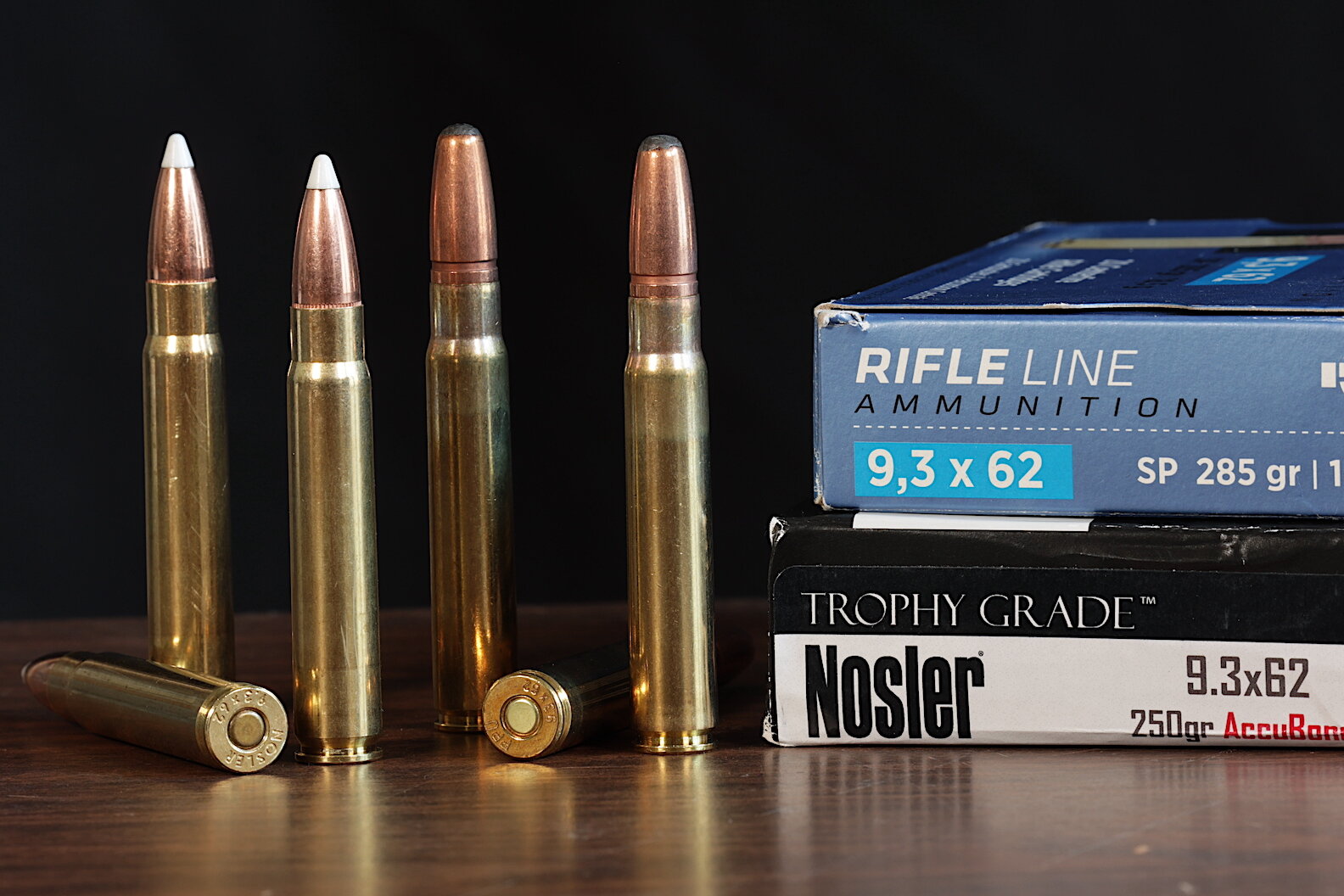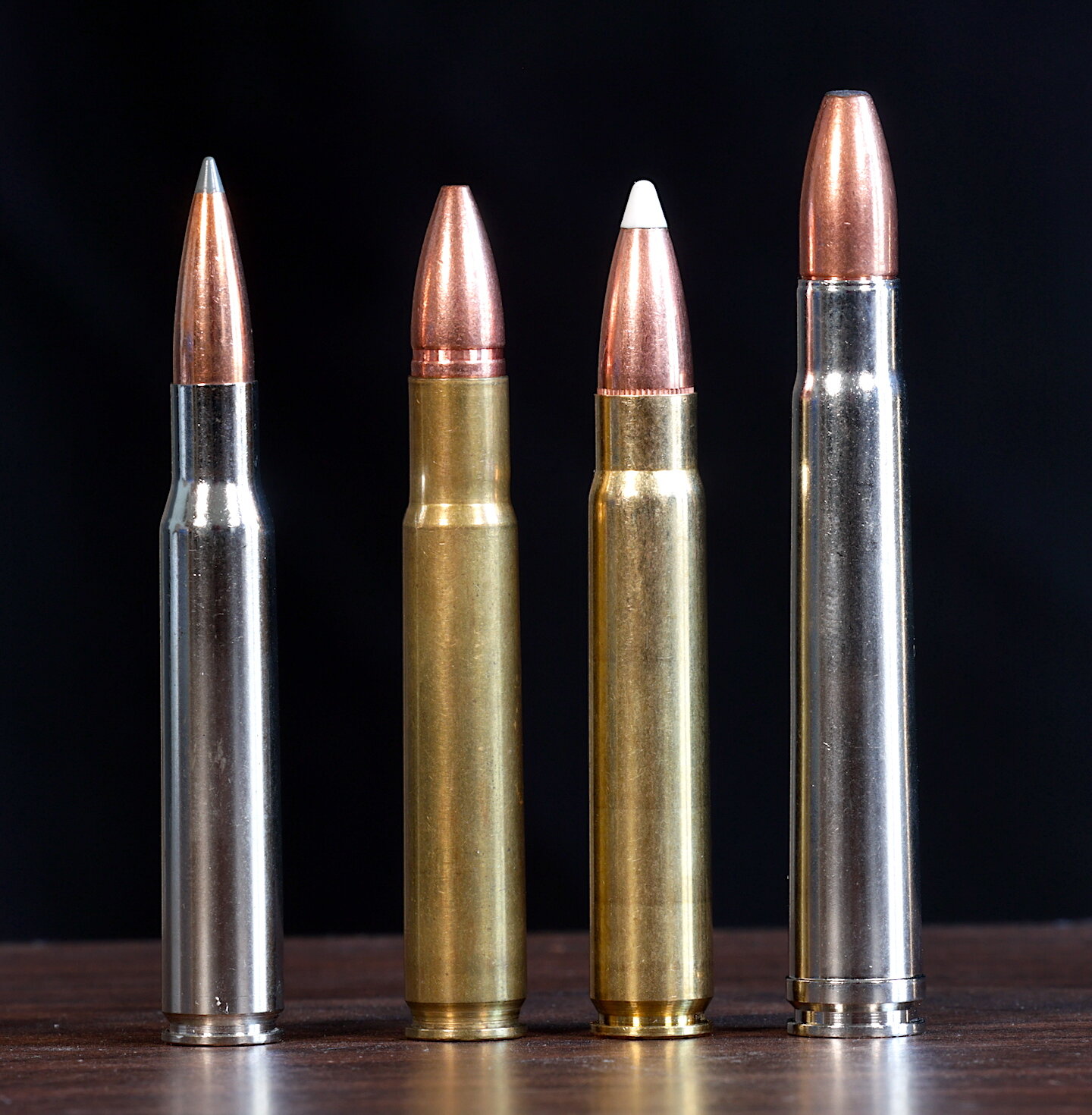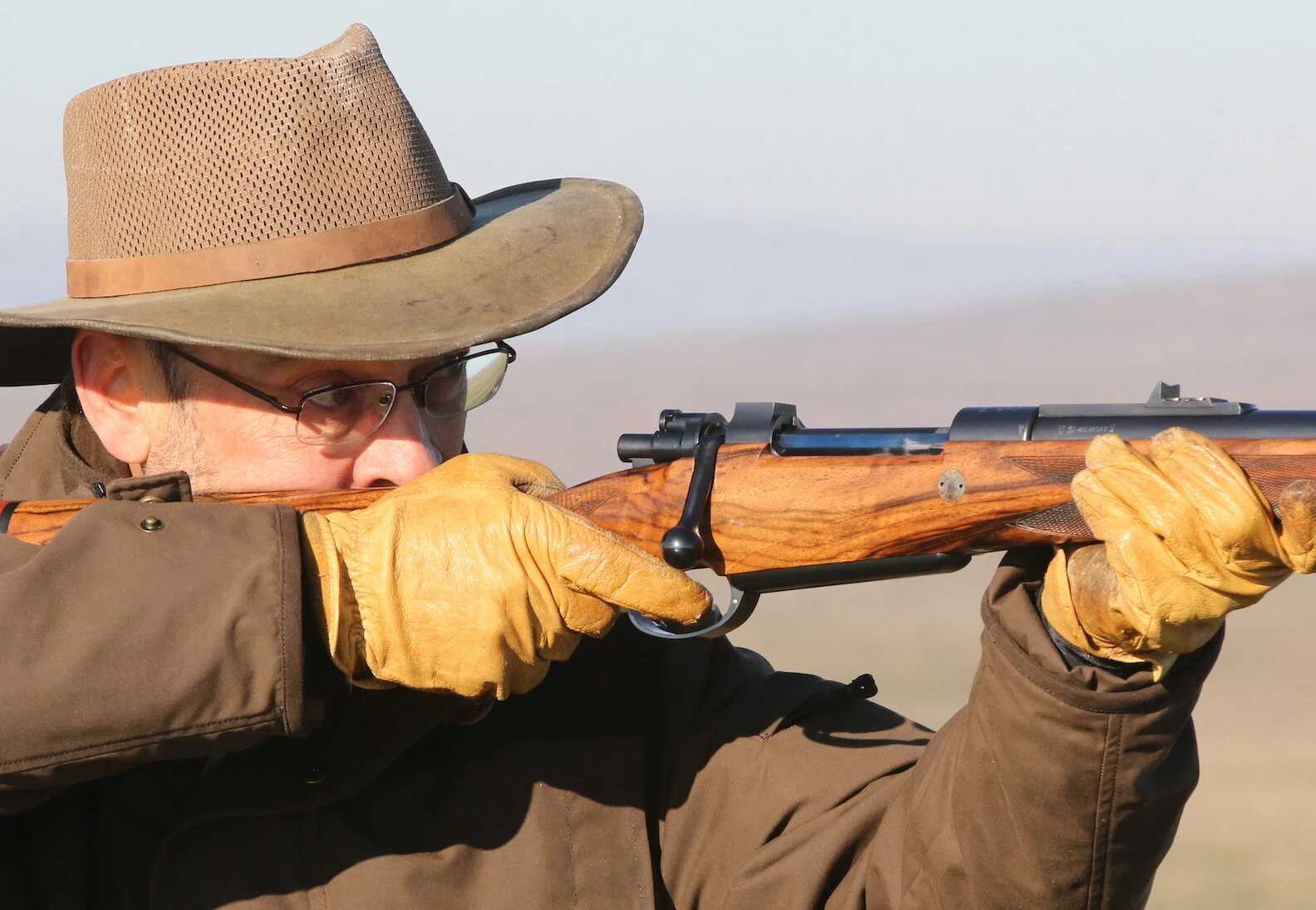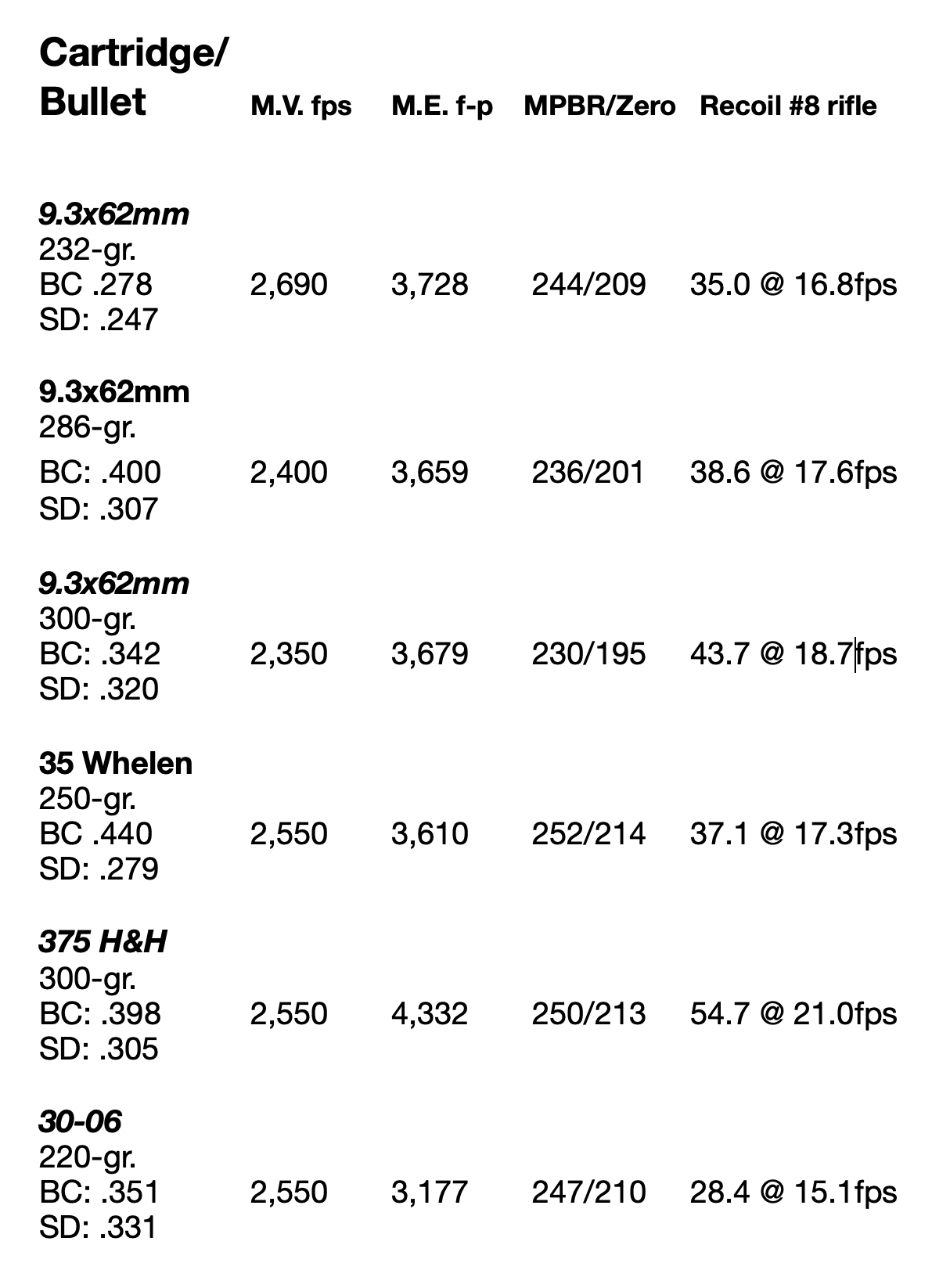The Surprising 9.3x62 Rifle Cartridge
The 9.3x62? As a firearms and hunting writer I expect to discover and investigate new guns and cartridges. I don’t anticipate discovering an old cartridge that’s trending. But this one is. The 9.3x62 of 1905 , which doesn’t even have a last name, is finally catching the spotlight in the USA.
Some call the German 9.3x62 the poor man’s 375 H&H. Some call it the perfect medium-bore, better than the 35 Whelen, certainly more powerful and versatile than the 30-06. Not bad for a cartridge born a year before the 30-06, seven years before the 375 H&H, and seventeen years before the 35 Whelen (which wasn’t officially commercialized until 1988.)
To put 1905 in perspective, it’s not only 116 years before today, but it predates WWI by almost a decade and the first commercial radio broadcast by 15 years. In 1905 Teddy Roosevelt was president and a German Jew named Einstein was revolutionizing humankind’s understanding of the universe via something called relativity.
The 9.3x62 proved so effective in Africa that it was exempted from minimum standards for dangerous game rounds, i.e. 375 H&H.
9.3x62 Echoes Dimensional Cousins
A German named Otto Bock created the 9.3x62 rimless cartridge out of whole cloth, although its dimensions look suspiciously like the 7x57mm Mauser of 1892. And that means it’s mirroring our 30-06 for rim, head, body diameter —even the 17-degree, 30-minute shoulder angle. While my Hornady Handbook of Cartridge Reloading shows the 9.3x62 having a head diameter of .467”, live rounds of that ammunition in my possession measure .472”. I guess that’s ok because a 30-06 cartridge on my desk that is supposed to span .470” at the head actually hits just .466”. Apparently there’s considerable fudge room in cartridge manufacturing tolerances.
One interesting conjecture about Bock’s potential blueprint for the 9.3x62 is the U.S. 30-03, the predecessor to the 30-06. The 30-03 was available two years before Otto announced his medium bore. Hmmm. Which chicken hatched which egg? Given the country of origin, it’s most likely Bock worked from or at least took inspiration from the 7x57 Mauser. Indeed, some call it the 9.3x62 Mauser even though it was not created by Paul Mauser. But it does have a strong Mauser connection.
Otto Bock’s original 9.3x62 (3rd from left) looks suspiciously similar to the 30-06 on far left, which was necked up to make the 35 Whelen (2nd from left.) The Whelen is known as the American 9.3x62 due to similar looks and performance. Both are also known as Poor Man’s 375 H&H. And both offer the kind of bullet diameter, mass, and punch many of us love for big deer, antelope, wild boar, and even dangerous game.
A Mauser Connection
Regardless its dimensional inconsistencies, Bock’s creation was clearly influenced by the M98 Mauser bolt-action rifle of Germany, then a rising star in Africa. Ivory hunter Karamojo Bell was employing one in the guise of a 275 Rigby Mauser. While European boar and stag required cartridges and bullets of this size, German pioneer farmers were probably the bigger market. In 1905 they were busy settling several colonies in Africa including Tanganyika and German Southwest Africa, today’s Tanzania and Namibia.
As you might imagine, pioneering farms had more than drought and locusts to contend with. Lions competed for their milk cows. Eland and buffalo trampled their crops. Leopards and hyenas nipped their goats, sheep, and chickens. They needed dependable rifles throwing bullets that stopped trouble without draining funds. Large-bore British double rifles of the area — designed and built for England’s wealthy upper crust — were not an affordable option, but a German-made Mauser was. And it offered other advantages like five rounds down and one up the spout. Combine that with the reliable controlled-round-feeding and strong extraction inherent in the Mauser action and the substantial width and mass of a .366” diameter bullet and you had a firearm as rugged and dependable as an axe, hoe, or sledge. The 9.3x62 took off.
As I noted in my video presentation on the 9.3x62, it proved so effective that it was grandfathered in when several African countries established minimum power levels at 375 H&H for dangerous game sporting rifles. Poor man’s 375 H&H indeed. One can hardly imagine the numbers of lions, leopards, hyenas, and buffalo shot off the fields and porches of African pioneer farmers with 9.3x62 Mauser rifles. Not to mention the eland and roan and sable and impala taken for the table.
Rifles built on the dependable Mauser controlled-round-feed bolt action were home to most of the early 9.3x62 cartridges. This rifle is the superb 416 Rigby on a magnum action. One chambered for 9.3x62 would be slightly trimmer.
The 9.3x62 Measures Up
In size the 9.3x62 case is a bit of an enigma, shown at several differing dimensions in various handloading manuals. Its rim is specified variably as .468”, .470”, and .473” with head diameter varying from .467” to .476”! I measured a Prvi factory round with .467” rim and .472” head. A Nosler factory load spread .4665” rim, .472” head. Standard for the 7x57mm Mauser and 30-06 family is .473” rim, .471” head.
Maximum case length of this 9.3 is 2.441” compared to the 30-06 length of 2.494”. Cartridge overall length of the 9.3x62 is 3.291”, just a tad shorter than the 30-06’s 3.340”. Clearly Mr. Bock’s creation lands smack in the wheel house for standard length action rifles with 7x57 and 30-06 diameter bolt faces. No need for a full magnum length action for handling this one.
Maximum average chamber pressure for the 9.3x62 is 56,565 psi, quite a bit more than the 51,000 psi of the 7x57 Mauser, but less than the 60,000 psi 30-06. Such chamber pressure limits strike many of us as odd considering similar cartridges like the 270 Win., often formed from 30-06 cases, are allowed 65,000 psi. Even the 6mm Remington, a necked down 7x57mm Mauser, is judged safe at 65,000 psi while its parent case is limited. Part of the reason for this is that when standards for those older rounds were established, smokeless powders were temperature sensitive and inconsistent. Safe pressures at 50-degreees F. in England could become destructively high at 100-degrees F. in Africa. The prudent thing was to err on the side of lower pressures.
Despite its low pressure rating, the 9.3x62 holds its own ballistically, spitting 232-gr. Norma Vulcan bullets 2,690 fps ahead of 59.7 grains of Norma 201 powder, according to Norma Reloading Manual 2013. (Trajectory table below.)
Both Hornady and Nosler handloading recipes show 286-gr. bullets from 24” barrels hitting 2,400 fps or slightly faster. This bullet size down to 250-grains appears to be the sweet spot for the 9.3x62, balancing muzzle velocity and energy for peak performance. The 300-grain A-Frame load at 2,350 fps shown in Swift Reloading Manual Number One doesn’t appear to offer significant advantages, as the accompanying chart shows, although momentum and penetration potential would be better.
9.3x62, 232-gr. Norma Vulcan, 2,690 fps
9.3x62, 286-gr. Horandy Interlock, 2,400 fps
9.3x62, 300-gr. A-Frame, 2,350 fps
Study these drop, drift, and energy tables and you begin to understand the appeal and versatility of the old 9.3x62 in Africa. With the 232-gr. bullet it shoots flat enough for a MPBR of 255 yards where it’s still carrying nearly 2,000 f-p energy. That’s with a 6-inch diameter target. While Sectional Density of that bullet at .247 isn’t high, it’s diameter of .366 coupled with its impact energy suggests it’s more than up to the task of inviting nearly any deer or antelope to dinner. That includes moose and eland, the world’s biggest deer and antelope. But for animals of that bulk one might want the higher SD (.305) and increased momentum of the 286-gr. Hornady. At 250 yards it is hauling 2,300 f-p energy. And MPBR is still a respectable 235 yards or so.
Pushing Weight Limits in 9.3x62
More than just a few Cape buffalo fell to German settlers packing 9.3x62 Mauser rifles. Undoubtedly rhinos, hippos, lions and leopards too.
But we can’t leave this “poor man’s 375 H&H” without pushing bullet mass limits. With a 300-grain Swift A-Frame aboard, SD rises to .320 and muzzle energy to 3,679 f-p. To me this suggest we’re running out of steam, yet Norma offers a 325-grain bullet option. Call that one Penetration Station. The 286-gr. bullet comes within 20 f-p of the 300-grain’s muzzle energy, but hangs onto more of it downrange; 84 f-p more at 100 yards. By 200 yards this climbs to a 156 f-p advantage. Unless one desires the higher SD for deeper penetration and/or plans to engage dangerous game inside of 100 yards, I see little reason to shoot the 300-gr. That said, bullet construction options could change this data. It behooves hunters to consider all aspects of ballistics, terminal as well as exterior. The right 286-grain bullet could outperform the wrong 300-gr. and vice versa. I know from experience the Swift A-Frame bores deeper than most. I’d put it up against any 300-grain of weaker construction.
Getting a Kick Out of the 9.3x62
This leaves recoil as our next judging criteria. My cartridge comparison chart below provides comparisons among 9.3x62 loads as well as three others in the same ball park. Understand that these muzzle velocities are not absolute. Factory loads, handloads, and different rifles/barrels could alter them by as much as 200 fps up or down.
The 35 Whelen is considered by many the U.S. equivalent to the 9.3x62. It’s numbers suggest that’s not a bad assessment, especially when you compare the 250-gr. in the Whelen to the 286-gr. in the 9.3. The numbers are so close that I’m not sure a blindfolded shooter could identify which he was setting off. I’m betting game hit in similar places couldn’t tell either. Certainly the 375 H&H bumps performance into another realm, but it requires a full magnum length action and about 10 grains more powder to get there. You pay the price in recoil, too.
For many the choice between the 9.3x62 and 35 Whelen might come down to gun and ammo availability. Neither is ubiquitous, but Mauser, Sauer, CZ, Tikka, Sako, and Blaser chamber the 9.3x62. Some special run Ruger bolt-action African rifles and the famed No. 1 have been chambered 9.3x62. Ditto older Belgian Browning bolts. Virtually any U.S. bolt action in standard length could be converted to 9.3x62 with a barrel change. Ammo is loaded not just by RWS, Lapua, Norma, and Sellier & Bellot, but by Federal, Hornady, Swift, Double Tap and Nosler.
In the age of high B.C. bullets and extreme range targeting, it seems passing strange that an old German warhorse like the 9.2x62 would be catching fire, but once you’ve studied it you begin to understand. And once you’d seen its performance on game, according to those who have, you’re sold. In the U.S. it is catching on as a bear round, celebrated as a hog terminator, and appreciated as an elk and moose anchor. Many who engage whitetails in heavy cover appreciate it for dropping big bucks where they stand or leaving a blood trail wide and short.
When assessing the 9.3x62 and wondering why it was such an immediate hit in Africa, we must remember that in 1905 there was no 375 H&H Magnum. Smokeless power had been available for fewer than 20 years and, given some erratic performance of early recipes, was viewed with suspicion by many traditionalists weaned on blackpowder cartridges pushing wide, heavy bullets. Mid-19th century dangerous game hunters were shooting 10-, 8-, 4-, and even 2-gauge guns — smoothbored or rifled — throwing 1- to 4-ounce lead balls and early conical bullets. Those were gradually replaced by various rimmed, blackpowder .577s and the 600 Nitro Express chambered in double barrels and single-shots. Anything smaller than 50-caliber was considered a medium bore or even “light” round suitable for only the smaller antelope. Velocities were topping out at around 1,800 fps. Mass was the name of the game. A mere stripling 36-caliber must have radically light for the era. Fortunately the 8x57 and 7x57 Mauser military rifles had plowed the ground. The heavy bullet paradigm was shifting and the 9.3x62 arrived as one of the first medium bores to ride the wave.
After a mere 116 years, the German 9.3x62 is finally catching some American limelight. Not bad for a medium bore that doesn’t even have a last name.










